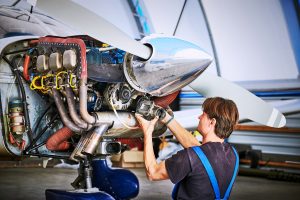“If you were going to bet on any industry’s future, aerospace and defense (A&D) isn’t a bad one to bet on,” said Scott Thompson, who leads the global aerospace and defense consulting practice of PricewaterhouseCoopers.
Apparently many major investors agree, since A&D is attracting huge amounts of private equity, and the infusion of new capital is widely expected to increase in 2022. “Fundamentals for [A&D] are starting to improve,” said Morgan Stanley analyst Kristine T. Liwag.
Thompson’s upbeat outlook for 2022 and beyond is based on a general consensus that air traffic demand, the engine that drives commercial aircraft manufacturing, will return to pre-Covid 19 levels of more than 5% compound annual growth rate within the next two years; the Defense Department will put defense modernization on a fast track; pressure on aviation to accelerate de-carbonization efforts will usher in more innovative propulsion technologies; and both the commercialization of space and DoD’s efforts to bolster the defensibility of the U.S.’s most critical space assets will continue to gain momentum.
“The [opportunities] in space are vast, and we see different drivers fueling commercial and government activity,” said Liwag. “The Pentagon’s recent recognition that space is now a warfighting domain has elevated space to one of the fastest-growing segments of the Defense Department’s budget.” On the commercial side of space business, she noted that the race to secure first-mover advantages is perhaps most evident in the emergence of rival mega-constellations designed to provide global internet access.
The barriers to space access will continue to fall, given recent innovations in miniaturization, processing power, and space-launch efficiencies, she added. One such innovation is Isotropic Systems’ recent demonstration of the first simultaneous connections with communications satellites in different orbits—its solid-state terminal linked to SES spacecraft in both geostationary and medium Earth orbits. Existing satellite communications terminals can link to only one network in one orbit at a time.
As for the improvements in processing power and miniaturization, they’re enabling smaller satellites to rival the capability, function, and performance of older, larger satellites. This is fueling the trend toward smaller, less expensive spacecraft that are easier to replenish.
Balancing these upbeat projections for 2022 is the sobering reality that A&D faces some major challenges next year and well into 2023—one of the most consequential being the net-zero carbon-emissions goal that aviation is facing.

As Thompson himself noted, the aerospace industry is galvanized to become carbon-neutral by 2050—a hard deadline set by the International Air Transport Association (IATA)—but there currently are no “silver bullet” technologies capable of allowing commercial aviation to meet that goal; it will require scaling up the use of Sustainable Aviation Fuel (SAF) as well as sustained investment in a combination of technologies.
One such initiative is a demonstrator program called the Revolutionary Innovation for Sustainable Engines (RISE). Its manufacturer, the team of CFM and GE, is targeting a 20% reduction in fuel consumption and CO2 emissions, compared with current engines. RISE has been designed as a successor to the current Leap turbofan engine, which powers narrow-body aircraft, such as the Boeing 737, a workhorse of commercial aviation. Work on this and other demonstrator programs will step up in 2022. The program, which is scheduled to culminate with flights tests around 2025, will include a suite of disruptive technologies supporting long-term sustainability goals.
Closely related is a scheduled flight demonstration of fuel-cell powertrains in regional turboprop aircraft in 2022 as interest in zero-emission hydrogen propulsion intensifies. While some startups, such as ZeroAvia, are backing hydrogen-electric as the fastest route to market, Airbus is set to test hydrogen combustion in existing turbine engines and conduct flight demonstrations of liquid-hydrogen tanks as it aims to field a zero-emission airliner by 2035.
To be compatible with aviation needs in terms of fuel density, hydrogen must be used in its liquid state, according to most aerospace propulsion authorities. This means it must be kept at a temperature of -235C (-391F). Designing and building the fuel system will be the biggest challenge.
Three other major challenges are likely to cast a shadow over aerospace in 2022: a shortage of qualified people to fill critical jobs; stress on the supply chain as original equipment manufacturers rebuild narrow-body production, and fuel prices; above $80 per barrel, airline customers generally consider the acquisition of new, more fuel-efficient aircraft worth the long-term investment.
On the labor front, the problem is two-fold: an insufficient number of the right people, particularly technicians on the factory floor trained in the use of digital tools, and the necessity of rehiring or finding new employees to make up for lost labor throughout the pandemic. “Labor is the main variable companies will need to flex as the industry attempts to ramp back up to pre-Covid levels,” Liwag said. Many analysts believe that labor will become a major competitive differentiator in 2022.